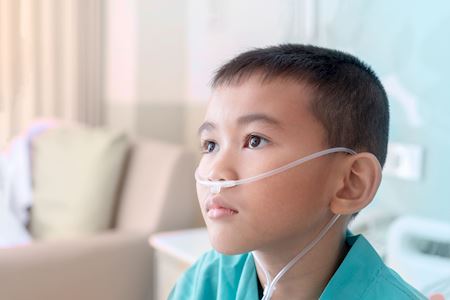1. Sixteen-year-old Ben experienced an asthma attack when he was warming up for a soccer game. The windy day may have produced a large amount of pollen in the air leading to the asthma exacerbation. Ben may have been able to control the attack but had left his rescue inhaler at home. In children and teenagers, asthma is often caused by allergens which elicit a type 1 hypersensitivity reaction in the lungs (see workbook). Smooth muscles surrounding the bronchi constrict. Mucus production also narrows the airways making it difficult to breathe. The volume of the thoracic cavity gets larger when inhaling but gets smaller when exhaling (see workbook). It is more difficult to exhale with an asthma exacerbation due to the decreased volume of the airways combined with the bronchospasm and mucus production.
2. Symptoms of an asthma attack include tightness in the chest, wheezing, and rapid, difficult breathing (tachypnea and dyspnea). Tachycardia may occur as the heart tries to compensate for the lack of oxygen to the tissues.
3. The severity of the asthma attack can be assessed by measuring oxygen saturation levels with a pulse oximeter and by assessing maximum exhalation with a peak flow meter.
 4. Ben was placed on oxygen to assist his breathing and then received three breathing treatments of albuterol sulfate delivered by a nebulizer. Albuterol relaxes the bronchial smooth muscle, enlarging the diameter of the bronchial and allowing the patient to breathe easier. Ben was also given Medrol, an oral corticosteroid. This class of drugs is used in severe exacerbations to reduce severe inflammation in the lungs.
4. Ben was placed on oxygen to assist his breathing and then received three breathing treatments of albuterol sulfate delivered by a nebulizer. Albuterol relaxes the bronchial smooth muscle, enlarging the diameter of the bronchial and allowing the patient to breathe easier. Ben was also given Medrol, an oral corticosteroid. This class of drugs is used in severe exacerbations to reduce severe inflammation in the lungs.
Individuals with asthma use a rescue inhaler to control asthma exacerbations. The inhaler contains a short-acting beta agonist to relax bronchial spasm. Inhaled corticosteroids are used to control asthma. These reduce lung inflammation and reduce mucus production. Long-acting beta agonists may be added if the physician feels they are necessary to control the patient's asthma. These dilate the bronchi over a longer period than a short-acting beta agonist. This list of medications is not comprehensive. One of the newer medications blocks IgE so that histamine cannot be released from mast cells.
5. In the United States, 8% of adults and 9.3% of children have asthma (CDC, 2014). Another way to look at this is about 1 in 12 individuals have asthma and these numbers are increasing yearly. The increase in asthma worldwide has been attributed to the increase of environmental chemicals including pesticides, solvents, and air pollutants. The prognosis for individuals with asthma varies with the time of onset of asthma and severity. Children that experience some wheezing with respiratory infections but no symptoms between infections, tend to not develop asthma. Children with symptoms that occur frequently tend to have asthma as adults. Children have a reduced chance of outgrowing allergy-induced asthma. Boys, however, tend to outgrow their asthma more frequently than girls.
If the asthma is mild to moderate, adults may become symptom-free. With appropriate treatment, even severe cases in adults may improve. In about 10% of cases, lung remodeling may occur leading to permanent problems with lung function.
6. Many studies have looked at the possibility of preventing asthma. Farms have a protective factor. Children living on farms are protected against asthma and even environmental allergens. Increases in air pollution and climate change are being studied as possible contributors to the increase in asthma cases worldwide. Risk factors for developing asthma include maternal smoking during pregnancy, exposure to secondhand smoke, and a significant respiratory syncytial virus (RSV) illness as an infant or child. Individuals that closely follow their asthma action plan can help reduce the risk of severe exacerbations.
7. In the emergency room, emergency physicians, nurses, and respiratory therapists helped aleve Ben's asthma attack. The ER physician started Ben on oxygen, made sure his vitals were stable and ordered the nebulizer treatments. Nurses assisted in taking vital signs, starting oxygen, and administering oral medications. The respiratory therapist assisted Ben with the nebulizer treatments and helped measure his peak flow levels. Ben will follow up with his primary physician to review his asthma action plan and change any medications as needed to help prevent future exacerbations.
